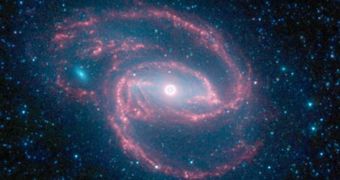A new, supermassive black hole, estimated to have 100 million times the mass of the Sun, has been discovered at the center of the NGC 1097 galaxy, located some 50 million light-years away from our planet. The formation became visible in a new Spitzer Space Telescope image, taken in the far- and near-infrared wavelengths, which shows an immense black hole surrounded by stellar nurseries, areas of active and explosive stellar formations. The hole in itself is naturally not visible, as matter and even light are attracted to it.
Because of the angle that the spiral galaxies make with our own Milky Way, the image appears as if taken from above. This reveals two elongated and perfectly defined arms, which rotate around a super-bright center. In that area of the galactic core, the supermassive black hole is feeding on cosmic gas and dust, as well as on stars, at times, when their orbits take them too close to the core. The new find dwarfs the “motor” in our own galaxy, which has, apparently, only a few million times the mass of the Sun, and is only a much smaller version of NGC 1097's.
“The fate of this black hole and others like it is an active area of research. Some theories hold that the black hole might quiet down and eventually enter a more dormant state like our Milky Way black hole,” California Institute of Technology (Caltech) expert George Helou, who is also the NASA Spitzer Science Center deputy director, says. “The ring itself is a fascinating object worthy of study because it is forming stars at a very high rate,” Kartik Sheth, also an astronomer at the Center, adds, Space reports.
The image also reveals massive numbers of older stars, which are depicted in blue, spread throughout the galaxy. According to the experts at the Center, the “spokes” that exist between the two arms may be caused by cosmic dust, overheated in the intense stellar-forming process that takes place at the core of the galaxy. In the center-left part of the photo, a larger, blue dot can be seen. This is not a star or cluster, but a companion galaxy. Helou explains that, “The companion galaxy that looks as if it's playing peek-a-boo through the larger galaxy could have plunged through, poking a hole. But we don't know this for sure. It could also just happen to be aligned with a gap in the arms.”

 14 DAY TRIAL //
14 DAY TRIAL //